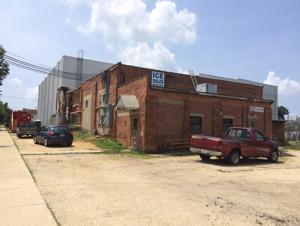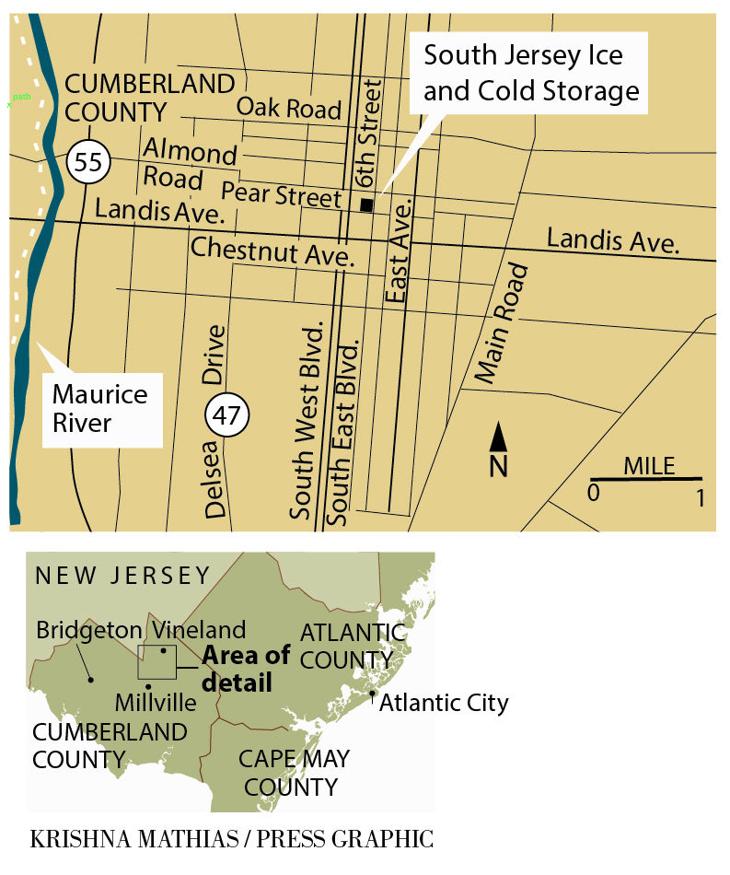
Tom Barlas, Staff Writer
South Jersey Ice and Cold Storage in Vineland.

Posted: Thursday, July 7, 2016 10:51 am
THOMAS BARLAS, Staff Writer
VINELAND — The threat of a potentially dangerous ammonia gas release from South Jersey Ice and Cold Storage on Thursday forced some residents to temporarily evacuate their homes and prompted emergency action by the federal government.
The U.S. Environmental Protection Agency already temporarily relocated the occupants of one home near the East Pear Street facility, and intends to do the same with people living in six other buildings, as a safety precaution.
Laura Coombs lives with three other adults and seven children in a house across from South Jersey Ice and Cold Storage. They were all scheduled to be relocated Thursday, although Coombs said they didn’t know when that would occur or where they were going.
Asked if she was concerned, Coombs replied, “Absolutely.”
Coombs said the air near the facility “tastes” of metal after a rainstorm. Coombs said she smokes, but said the cough she developed since moving to the house about five years ago “isn’t a smoker’s cough.”
“It’s more tight and deep,” she said as she held her chest.
Coombs said one of the children who lives in the house also developed a respiratory problem, but doctors can’t find a reason for the ailment.
Other residents near the business received instructions from the EPA on what to do should the EPA have to issue a “shelter in place” order prompted by an ammonia gas release.
The potential for the ammonia gas leak was caused by the “state of disrepair” of the company’s refrigeration system, a problem discovered during a recent routine inspection by the city Fire Department, said Dwayne Harrington, the EPA’s on-scene coordinator. Among the problems discovered were corroded valves and piping, he said.
The refrigeration system uses anhydrous ammonia, a colorless, toxic gas with a pungent and suffocating smell that can irritate the eyes, skin and respiratory and gastrointestinal tracts in cases of short-term exposure, the EPA said. Long-term exposure, and short-term, highly concentrated exposure, “does have the potential of permanent injury, and in some cases, death,” Harrington said.
The greatest danger of an ammonia release should occur this weekend, when the EPA installs a special scrubbing device to remove an estimated 12,000 pounds of ammonia from the business’ refrigeration system, said Harrington. The device would essentially help dilute the ammonia in the event of a gas release, the EPA said.
The relocated residents, who will stay at motels at the EPA’s expense, should be able to return their homes Sunday, when the scrubbing device installation is expected to be finished, Harrington said. The removal of the ammonia should take about three weeks, he said.
The EPA eventually will determine whether any penalties will be imposed against the company, he said.
Officials with the company, also known as Vineland Ice and Cold Storage, referred questions to their attorney, Jeffrey DiLazzero. DiLazzero didn’t respond to a request by The Press of Atlantic City for comment.
Officials with the city’s Health Department referred comment to Harrington.
Residents in the area were concerned about the problem Thursday.
In a house next door to Coombs, 67-year-old Tomasita Vargas said she, her husband and son were getting ready to pack. She said they did not plan to take much, as the EPA said they would only be away from home for a few days.
Vargas, who has one leg, was in bed Thursday as she spoke. She said she was not sure how difficult the temporary move would be, given her situation.
Another nearby resident, Glory Delgado, wasn’t being relocated, but received warnings about what could happen. She said she was sending her two sons, ages 17 and 13, to stay with their father while the work at the plant progresses.
Delgado, 36, who does babysitting work, said she was prepared to stay in her house despite the warnings, and was taking all necessary precautions should she have to shelter in place. That includes closing all her windows — something that could make her home uncomfortable during this stretch of hot weather.
“I’m more concerned about the people who live next to the place,” Delgado said.
The EPA said the company has operated on the site since 1922. It stores ice and other frozen items, such as fish.
“The refrigerator system is currently in poor condition and causing issues, including excessive frost buildup on cooling coils,” an EPA statement said.
The EPA said staff and contractors are now on the site around the clock. Six air monitors are in place around the business, providing air samples that the EPA analyzes on a 24-hour basis.
“If the air monitors detect levels of ammonia at 15 parts per million, EPA and Vineland emergency response officials will know immediately and will begin community protection and notification procedures,” the EPA statement reads.
Three wind socks also will be installed to track wind direction, the EPA said.
The EPA is already working on another project in the city.
That involves the cleanup of the Kil-Tone Co. site on Chestnut Avenue. The site of the former pesticide-manufacturing plant is contaminated with lead and arsenic.
The Kil-Tone site was recently added to the federal Superfund list.